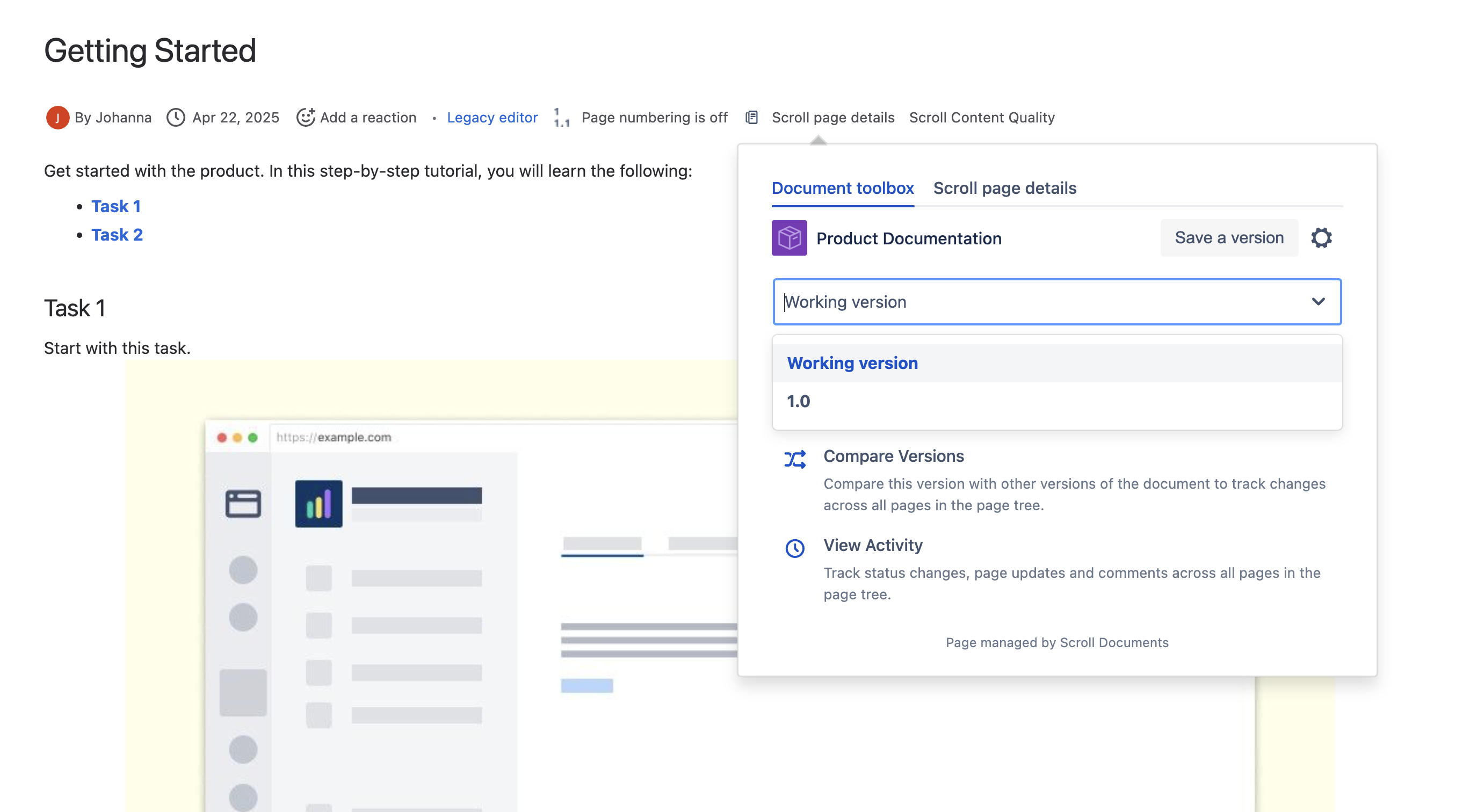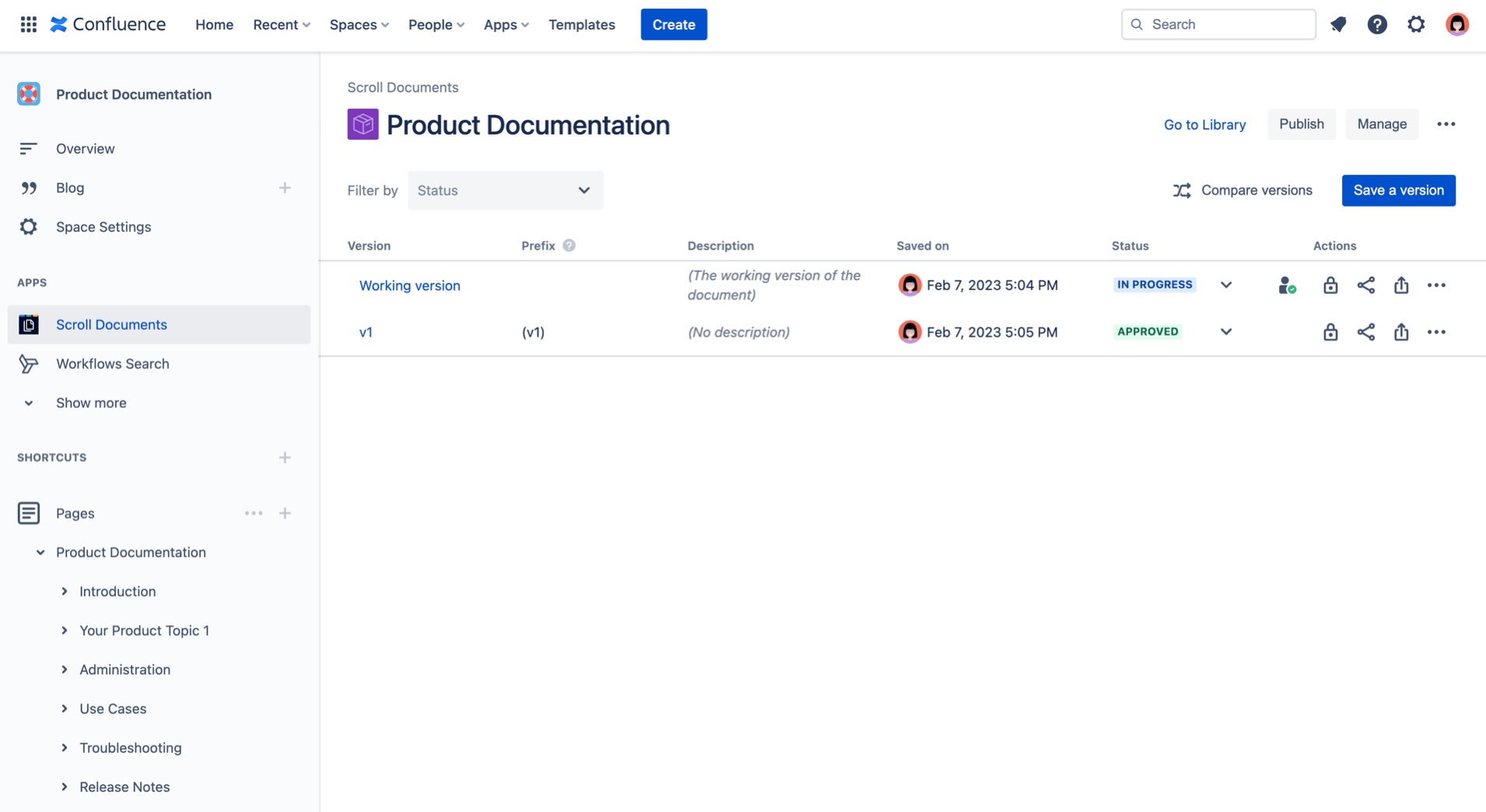Scroll Documents makes it easy to manage multiple versions of your content. This article explains how versions are structured, how to navigate between them, and how to customize version organization.
View All Versions
You can access your saved versions and the Working version from several places:
Where
The version picker in the Document toolbox.
Preview

The version history table in the Document Manager.

The version page trees in your space sidebar.

To display a full list of all your saved version (excluding the Working version) within your document, embed the Scroll Document Version History macro on any page that is part of one of your version page trees.
How Versions Are Organized
Learn how Scroll Documents organizes your versions.
Working version vs. Saved versions
Every Scroll Document starts with a Working version. When you save a version, Scroll Documents creates a snapshot (copy) of the Working version’s page tree and stores it under a new default parent page .
What content Scroll Documents defines as the Working version depends on how you create the document :
-
Create new page tree: Creates an entirely new page tree at the top level of your Confluence space.
-
Use existing page tree or Enable Scroll Documents: Use one of your existing page trees in your Confluence space. The page tree is left in its original location.
Saved versions are fully independent and unaffected by future changes to the Working version.
Version prefixes
Each time you save a version, Scroll Document creates a new, independent copy of your page tree. The saved version’s pages are prefixed to avoid duplicate titles and help navigation.
You can edit the version name and prefix during and after saving the version, via the version details .
Version order
The version picker follows the order shown in the version history table:
-
The Working version always appears first in the version history table.
-
Saved versions are sorted alphabetically by their version name (Z–A). To change the order, you'll need to adjust the version names.
“Versions of” parent page
When you save your first version, Scroll Documents creates a version location page called “Versions of [Document Name]” to store all saved versions underneath.
Similar to a folder, this parent page helps you to keep your saved versions well organized and separate from your Working version. The page tree of the Working version remains in its default location.
The order of your version page trees in the space sidebar is controlled by Confluence. Typically, the page trees are arranged by title (like the version history table).
Do you want to customize your version structure?
To customize how versions are saved or organized, continue reading this section.
Save versions based on other saved versions
If needed, you can save a version from any other saved version (instead of the Working version).
To base a new version on an existing saved version:
-
Click Save a version.
-
Go to the Advanced tab.
-
Select a version from the Based on version dropdown.
The newly created version is a fully independent copy of the version it’s based on. Changes made in one version’s page tree won’t appear in the other. To merge updates between versions, you’ll need to manually copy and paste the content, or use the Overwrite feature .
Customize “Versions of” page
You can change the page title of the default “Versions of” parent page. You can also add, edit, or delete any content on this page.
We don’t recommend you delete the “Version of” parent page. Keeping all your saved version page trees under one parent page will help you stay organized.
Move or hide versions
You can move your version page trees within your space hierarchy. If you want to relocate your saved versions, we recommend moving the entire “Versions of” page tree to keep all saved versions organized in one place. After moving it, newly saved versions will be stored in the new location.
To hide saved versions:
-
In the page tree navigation: Move the version page trees to the top level of your space hierarchy.
Avoid moving individual pages out of a version page tree unless you intend to remove them from that specific version.
-
Globally: Apply view restrictions to the "Versions of" parent page to hide all saved versions.
Keep in mind that users who can’t access the “Versions of” page won’t be able to save new versions.
